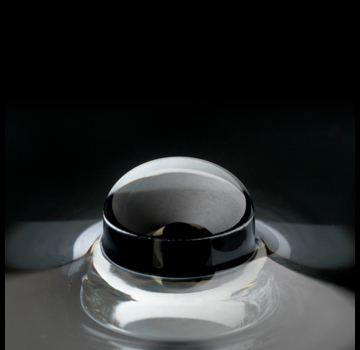
[Image: McCormick School of Engineering, Northwestern University]
Historically, lens making has involved a long, expensive process of polishing and grinding. But a new method from engineers at Northwestern University, USA, has the potential to create optical imaging lenses in a fraction of the time and at a fraction of the cost (Adv. Mater., doi: 10.1002/adma.201705683).
Using this method, the researchers 3-D printed a customized aspheric 5-mm-thick, 3-mm-wide lens. Although the Northwestern team is not the first to 3-D print a high-quality lens, it is the first to do so in such a short timeframe—four hours.
Speed versus accuracy
3-D printing builds up objects layer by layer based on a computer-aided design model. However, the implicit speed–accuracy trade-off has limited the practical applications of this technology in optics.
That’s because improving the surface finish and accuracy of a printed object, such as a lens, usually involves reducing the size of the individual volume elements, or voxels, that approximate the surface shape. That significantly slows down the process of building up the surface. Reducing the voxel size by 10 times, for example, will increase the fabrication time by a factor of a thousand. As a result, according to the research team, building up a millimeter-sized lens with sub-100-nm voxels can take literally weeks of fabrication time.
Speeding up, smoothing out
To address this dilemma, the Northwestern team began with a previously developed, highly parallel 3-D printing process, projection micro-steriolithography (PµSL). The PµSL method significantly speeds up the fabrication process by photopolymerizing each 2-D layer in the model in a single exposure, rather than point by point. But it results in a comparatively rough, pixellated surface.
To smooth things out, the research team applied two additional methods: grayscale photopolymerization and meniscus equilibrium post-curing. “First, we used grayscale images to create more transitions between steps,” Cheng Sun, the team leader and an associate professor of mechanical engineering at Northwestern, said in a press release accompanying the work. “Then, we coated the surface with the same photo-curable resin. That then forms the meniscus that further smooths the surface.”
Strategically combining the grayscale photopolymerization and meniscus equilibrium post-curing methods allowed the team to fabricate a lens with deep subwavelength surface smoothness (less than 7 nm) and obtain sub-voxel accuracy (less than 5 µm). Integrating these two processes allowed the researchers to completely remove the pixelated surface roughness from the PµSL technique without sacrificing speed.
The team’s first attempt at printing an optical component, without the two-step process, resulted in a rough surface that Sun described as “incapable of clear optics.” After implementing the two-step process, the researchers eventually achieved a smooth, transparent lens. The final prototype demonstrated a maximal imaging resolution of 373.2 line pairs per millimeter, with low field distortion (less than 0.13 percent across a 2 mm field of view). This was accomplished using a fabrication speed of 24.54 mm3 h⁻1, without compromising fabrication accuracy, according to the researchers.
Picture perfect
As a demonstration of the lens’ potential, the team attached the printed prototype lens to a cellphone camera to confirm its optical quality. By taking pictures through the lens, the researchers say they have confirmed not only the lens’ ability to support high-resolution images, but also its low distortion across a broad visible spectrum.
In the future, the team wants to improve the 3-D-printed lens by optimizing the UV-curable resin and coating materials, resulting in a more durable anti-scratch product. And while the proof-of-principle lens focused on the up-facing optical surface, the team believes it’s possible to extend the process to the down-facing surface by programming the effect of the gravity force.
According to the researchers, this new method could lead to the rapid prototyping of many novel devices “with a tremendous impact on freeform optics and biomedical imaging.”
